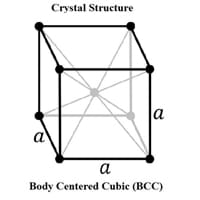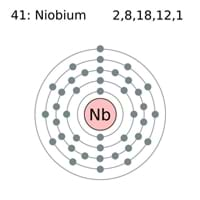What is Niobium?
Periodic Table
0
Symbol
Nb 0
Group Number
5 13
Period Number
5 3
Block
d block 0
Element Family
Transition Metal 0
CAS Number
7440031 76
Space Group Name
Im_ 3m 0
Space Group Number
229.00 1
Facts
0
Interesting Facts
- Niobium metal was used to get called Columbium in past.
- Niobium metal found freely in nature (abundance).
Sources
By-product of Tin Extraction, Found in Minerals, Mining, Ores of Minerals 0
History
0
Who Discovered
Charles Hatchett 0
Discovery
In 1801 0
Abundance
0
Abundance In Universe
2 * 10-7 % 22
Abundance In Sun
~0.0000004 % 23
Abundance In Meteorites
0.00 % 35
Abundance In Earth's Crust
0.00 % 25
Abundance In Oceans
0.00 % 34
Abundance In Humans
Not Available 0
Uses
0
Uses & Benefits
- Niobium alloys are used in jet engines and rockets and spacecraft, beams and girders for buildings and oil and gas pipelines.
- It is used superconducting magnets in particles accelerators, NMR and MRI equipment.
Industrial Uses
Aerospace Industry, Ammunition Industry, Electrical Industry, Electronic Industry 0
Medical Uses
NA 0
Other Uses
Alloys 0
Biological Properties
0
Toxicity
Low Toxic 0
Present in Human Body
Yes 0
In Blood
0.01 Blood/mg dm-3 25
In Bone
0.07 p.p.m. 25
Physical
0
Melting Point
2,468.00 °C 6
Boiling Point
2,468.00 °C 45
Appearance
0
Physical State
Solid 0
Color
Gray 0
Luster
Metallic 0
Hardness
0
Mohs Hardness
6.00 6
Brinell Hardness
735.00 MPa 14
Vickers Hardness
870.00 MPa 12
Speed of Sound
3,480.00 m/s 21
Optical Properties
0
Refractive Index
Not Available 0
Reflectivity
Not Available 0
Allotropes
No 0
α Allotropes
Not Available 0
β Allotropes
Not Available 0
γ Allotropes
Not Available 0
Chemical
0
Chemical Formula
Nb 0
Isotopes
0
Known Isotopes
17 22
Electronegativity
0
Pauling Electronegativity
1.60 23
Sanderson Electronegativity
1.42 16
Allred Rochow Electronegativity
1.23 25
Mulliken-Jaffe Electronegativity
Not Available 0
Allen Electronegativity
1.41 31
Electropositivity
0
Pauling Electropositivity
2.40 31
Ionization Energies
0
1st Energy Level
652.10 kJ/mol 41
2nd Energy Level
1,380.00 kJ/mol 50
3rd Energy Level
2,416.00 kJ/mol 50
4th Energy Level
3,700.00 kJ/mol 49
5th Energy Level
4,877.00 kJ/mol 36
6th Energy Level
9,847.00 kJ/mol 11
7th Energy level
12,100.00 kJ/mol 14
8th Energy Level
Not Available 0
9th Energy Level
Not Available 0
10th Energy Level
Not Available 0
11th Energy Level
Not Available 0
12th Energy Level
Not Available 0
13th Energy Level
Not Available 0
14th Energy Level
Not Available 0
15th Energy Level
Not Available 0
16th Energy Level
Not Available 0
17th Energy Level
Not Available 0
18th Energy Level
Not Available 0
19th Energy Level
Not Available 0
20th Energy Level
Not Available 0
21st Energy Level
Not Available 0
22nd Energy Level
Not Available 0
23rd Energy Level
Not Available 0
24th Energy Level
Not Available 0
25th Energy Level
Not Available 0
26th Energy Level
Not Available 0
27th Energy Level
Not Available 0
28th Energy Level
Not Available 0
29th Energy Level
Not Available 0
30th Energy Level
Not Available 0
Electrochemical Equivalent
0.69 g/amp-hr 66
Electron Work Function
4.30 eV 18
Other Chemical Properties
Anti Corrosion, Ionization, Radioactive Isotopes, Solubility 0
Atomic
0
Atomic Number
41 71
Electron Configuration
[Kr] 4d4 5s1 0
Crystal Structure
Body Centered Cubic (BCC) 0
Crystal Lattice
BCC-Crystal-Structure-.jpg#100 0
Atom
0
Number of Protons
41 70
Number of Neutrons
52 53
Number of Electrons
41 70
Radius of an Atom
0
Atomic Radius
146.00 pm 35
Covalent Radius
164.00 pm 28
Van der Waals Radius
200.00 pm 28
Atomic Weight
92.91 amu 65
Atomic Volume
10.87 cm3/mol 45
Adjacent Atomic Numbers
0
Previous Element
56 0
Next Element
34 0
Valence Electron Potential
104.00 (-eV) 8
Lattice Constant
330.04 pm 51
Lattice Angles
π/2, π/2, π/2 0
Lattice C/A Ratio
Not Available 0
Mechanical
0
Density
0
Density At Room Temperature
8.57 g/cm3 48
Density When Liquid (at m.p.)
Not Available 0
Tensile Strength
330.00 MPa 12
Viscosity
Not Available 0
Vapor Pressure
0
Vapor Pressure at 1000 K
Not Available 0
Vapor Pressure at 2000 K
0.00 (Pa) 27
Elasticity properties
0
Shear Modulus
38.00 GPa 19
Bulk Modulus
170.00 GPa 10
Young's Modulus
105.00 GPa 20
Poisson Ratio
0.40 4
Other Mechanical Properties
Ductile, Malleable 0
Magnetic
0
Magnetic Characteristics
0
Specific Gravity
8.57 37
Magnetic Ordering
Paramagnetic 0
Permeability
Not Available 0
Susceptibility
Not Available 0
Electrical Properties
0
Electrical Property
Conductor 0
Resistivity
152.00 nΩ·m 23
Electrical Conductivity
0.07 106/cm Ω 28
Electron Affinity
86.10 kJ/mol 12
Thermal
0
Specific Heat
0.26 J/(kg K) 20
Molar Heat Capacity
24.60 J/mol·K 50
Thermal Conductivity
53.70 W/m·K 29
Critical Temperature
Not Available 0
Thermal Expansion
7.30 µm/(m·K) 48
Enthalpy
0
Enthalpy of Vaporization
696.60 kJ/mol 4
Enthalpy of Fusion
27.20 kJ/mol 6
Enthalpy of Atomization
745.00 kJ/mol 4
Standard Molar Entropy
36.40 J/mol.K 42
|
||
|
||
|









